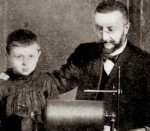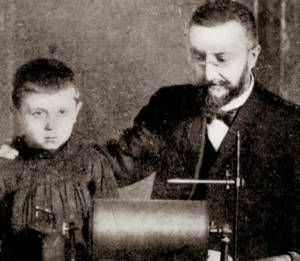
 A. Binet and Laraze, Paris, 1885.From the outset, the measurement of intelligence was as much a scientific as an eminently political endeavour.
A. Binet and Laraze, Paris, 1885.From the outset, the measurement of intelligence was as much a scientific as an eminently political endeavour.
In 1905, in Rome, the 5th International Congress of Psychology heard a presentation of the first widely used intelligence test, to be known as the Binet-Simon Intelligence Scale after its joint authors, French psychologist Alfred Binet (1857-1911) and psychiatrist Théodore Simon (1873-1961). It was then one of the “new methods aimed at diagnosing idiocy, imbecility, and moronity”; together with pedagogical and medical methods, it would be possible to detect “abnormal” children within a class, but also to distinguish among them the “idiots” from the “imbeciles”, the “morons” from the “feeble-minded”. In any case, it had been devised for this, at the request of the French authorities.
The matter of the detection and education of “abnormal” children had been an issue in France since the adoption of the Jules Ferry Laws on education in 1881 and 1882. A deputy, Dr Désiré-Magloire Bourneville (1840-1909) had been seeking, ever since joining Bicêtre’s paediatric services in 1879, to transform the oversight of retarded children and to redirect them to fully fledged schooling. Therefore, he had presented in 1889 a bill revising the 1838 law on the insane and proceeded to denounce, at the 1894 national congress of the French Public Child Welfare Agency, the parlous situation of so-called abnormal children in the country. The necessity to offer these children an education was no longer in question. At the turn of the new century, all that remained to determine was where to educate those children. Was it within the asylums, as Bourneville had done at Bicêtre, or in specialised classes within state schools as Binet and Simon advised?
That question was going to be answered by a commission tasked, in 1904 by the Ministry of Public Education to survey the way “abnormal” children were being educated in compliance with the 1882 law on compulsory primary education. Seeking as a first step a census of “abnormal” children, the Bourgeois Commission – named after its chairman, the statesman Léon Bourgeois (1851-1925) – entrusted Binet and Bourneville with the task of devising a questionnaire to be used by the headmasters and teachers in the country’s schools. However, the results of this consultation were disappointing essentially because identifying “abnormal’ children remained difficult for want of a uniform classification and an effective screening tool. The Commission then asked Binet to remedy the situation.
On the basis of observations made in Paris Schools as well as in the Salpêtrière service of Dr Jules Voisin (1844-1920), Binet and Simon accordingly developed a differential diagnosis system helping to sort “normal” from “abnormal” children – and among the latter the diverse categories of abnormality or retardation. It was the famed Metric Scale presented at the international congress in Rome. The Commission seemed happy with this instrument since it completed its work at the end of 1905. They advocated for the creation of special classes and of special “improving” establishments designed to house children outside mental institutions. These recommendations were taken up unchanged by the minister of Public Education, Aristide Briand (1862-1932), who put forward on 13 June 1907, a bill for the creation of those new educational infrastructures.
In that same year, Binet and Simon published a Guide for the Admission of Abnormal Children into Special Classes, founded in the Commission’s findings, and it proposed practical tools towards the screening and classification of “abnormal children”. Binet and Simon also set forth the results of what they had observed in all the early improvement classes they had opened in several Paris schools, even before the law was passed on 15 April 1909. Coincidentally, the studies effected in these experimental classes would enable them to publish as early as 1908, the finalized version of their Metric Scale. Henceforth, it was possible to set an intelligence level corresponding to the age, in other words the mental age specific to each child. The Binet-Simon tests had arrived.
Références :
A. Klein, « Alfred Binet et l’Échelle métrique de l’intelligence », Bibnum [on line], 2016.
Y. Pelicier and G. Thuillier, « Pour une histoire de l’éducation des enfants idiots en France (1830-1914) », Revue Historique, 261(1 (529)), 1979, p. 99-130.
To quote this this paper : Alexandre Klein, "Test d'intelligence" in Hervé Guillemain (ed.), DicoPolHiS, Le Mans Université, 2021.